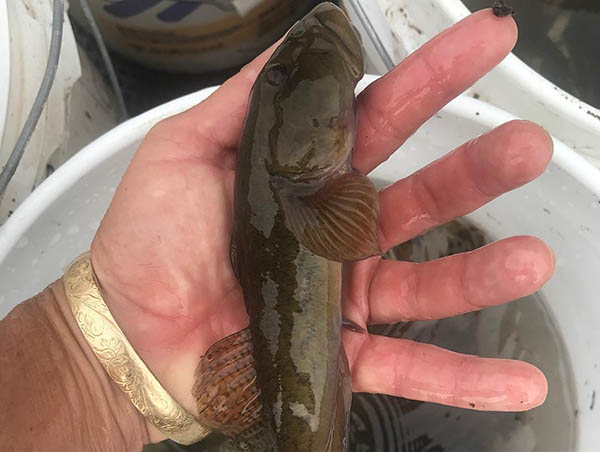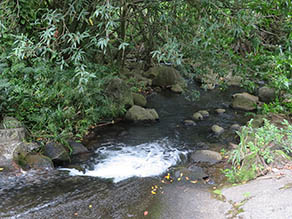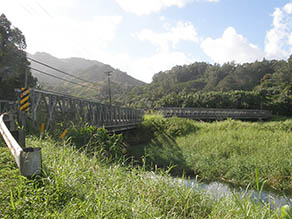 |
 |
 |
|||||
Freshwater Animals ‘O‘opu nākea. Photo by Hi‘ilei Kawelo. There are three types of freshwater animals that the residents of Hā‘ena eat: ‘o‘opu, hīhīwai, and ‘ōpae. ‘O‘opu: The guidebook to Limahuli Gardens explains that "These fish, ‘o‘opu, evolved from saltwater ancestors in the goby family. Although ‘o‘opu live in freshwater streams as adults, their fertilized eggs wash downstream, and young ‘o‘opu must spend their first several months of their lives in the ocean. Four of the ‘o‘opu species have a very interesting and useful adaptation. Their pelvic fins are fused together to form a suction cup which helps them fasten to rocks, the stream bottom, and even to climb waterfalls." These small native fish figure prominently in Hawaiian sayings. Here are several:
“My dad always said ‘o‘opu don’t want to say in a stone-walled area,” Samson tells us, “so any small opening on the side, that’s where the ‘o‘opu would be. So in those ditches: full! Loaded! All the side streams: loaded. We used to put, you know the old trunk? We used to bust in the lid, put chicken wire, and go look where there one good drop, put em right here. Make sure the bottom in the water. When the ‘o‘opu fall in, well, we used to pick em up four oclock in the afternoon. They drop in, they stay in the trunk. The only thing would get jam up, if somebody going up there, going try catch all these ‘o‘opu, they going trail the trunk out. That’s what we used to do. After that, send somebody to open everything. Whatever you don’t pick up, you can leave them—for the next guy. “The other thing we used to do when we like ‘o‘opu, if our mother like ‘o‘opu, we block the stream. Take taro patch mud, wad 'em with the stone and mud, and with a slap, plug 'em with the mud and seal 'em. Just put stone wall and plaster there, and dry 'em out. Then go pick em up. Half an hour. Just pick up the kind kicking. In the pond, don’t even bother with them. Pick up enough, then you go back there and open up. Where the pond is, don’t even bother, because you cannot catch them, they swim away. Just go to those shallow place where they’re stranded. Don’t even bother with the pond, pass ‘em. Go down the beach, you get loaded, going to see them all over. The water spreads out there, crazy all over. “Then send somebody to open everything. Whatever you never pick up, you leave ‘em for the next guy. So everybody tell me, ‘Eh, we catch plenty ‘o‘opu!’ I don’t say nothing. You don’t know how this catching ‘o‘opu! “But she [Rachel] was the one showed us how to block that stream. Don’t need special equipment, just take that mud, and seal that water. But now, there plastic, paper, maybe that would be more easy.” “You know Maniniholo?” Kelii asks. “Right there at the crossing, right on the right hand side there, used to be our swimming pool. There was a deep, deep hole there, makai side —you could jump from the top where the mango tree is, and jump down, that thing was deep, real, real blue, crystal blue. When there was big water, we knew we could catch the o‘opu and we go right in that pond because the ‘o‘opu come down. We walking across the road and then we decide to go hook. We just take our little sugi [fishing line] and our hooks, and we go down there. “We go look for a piece of java plum. We look for the young shoot, the long one. We just break them, make our own pole right there, and we used to go hook with that. Dig the worms right there, hook them on the top, and what I used to do when I catch them: break another branch off the java plum and poke ‘em all through the gills. Put all the ‘o‘opu, it would be all on top the branch. Walk home. And my father them, my father-in-law, my mother, did love the ‘o‘opu. I never did care for that fish. I love to go hook them, but I never did care to eat the fish. They were big kind ‘o‘opu [‘o‘opu nākea], like three inches around, a foot long, some more like fifteen inches." "The season used to be the rainy season during the summer," Nalani points out. “And we used to set nets along the double bridges. Every family had their spot for fishing, their spot where they go catch. So many feet apart. Everybody had their section to fish in. That was the respect, right? It wasn’t about like now, you just go and do what you want. No, everybody respected that. This is where this family fish, this where that family fish—like that.” “We love ‘o‘opu,” smiles Lahela. “I used to learn hooking from my brothers. I used to be fascinated going, doing what the boys were doing. We’d get our own bamboo, our own line, get a worm, dig inside the pasture, dig ‘em up, find all the worm, and right down below where we live we could go right inside the Wainiha river and catch. Now, ‘o‘opu is the million dollar fish. Because it can be caught in huge quantities. It’s like there’s a law, you can get arrested or go jail for that, but it’s been like that for like years: when they know the time they coming out, they can get like 1,000 pounds. The ‘o‘opu are maybe ten, eleven inches long, but they are very bony fish. They’re slimy, it’s a taste you got to enjoy that. I like it either fried or in soup. There is a bitter bag inside so you have to know how to open it and pull that out so it’s not bitter. I never eat it raw. My Mom said she has, she loves it! I’m like ugh, not for me. “I think the females are best and that is when you want the eggs inside of it to eat, because it’s more tastier than just not having nothing. And it’s lots of bones. You’ve got to be very careful because you can get a bone in your throat. Unless you fry them good.” “Eat ‘em while they in season,” Samson advises, “‘cause you not gonna get ‘em afterwards. Eat till you filled. Old folks, they like ‘em steamed, or boiled, or lawalu. I like em fried, I like em speed—I just fry em. Ono, though, when ready you eat em, ono—tasty. I put in a bit of salt, and ti leaf. Oh, that aroma is something, that taste!”
Hīhīwai: “I learn how for do hīhīwai on my own,” says Lahela. “The river is right along where the rocks are by the farm and I used to pick up. The family used to. We used to make them for home or we make for the lū‘au’s. raw is my favorite way to eat them. They’re still around, but because people want to use it for their lu‘au, it’s like same like the ‘o‘opu: they just come and raid them. People come from all over, sneak in the pasture. Lumahai is another famous place. But I haven’t checked by the farm now that I’m bigger. I think I can just crawl over the rocks. “When I was young I could be floating and go all over the river. The best time to pick that was in the evening, when the sun’s just going down and the hi‘iwae comes up on the rock. Otherwise you have to dive, we always had to have goggles and dive for them, and lift off the rocks to find them. They’re delicious. Our parents teach us how for do it raw. Only few people can eat it like that. With Hawaiian salt and garlic, that’s the secret, because it’s slimy like a snail and you let it sit so the salt will help to bring it out, because it’s hard to pull it out from the shell, it’s really hard.” “Hīhīwai, you can only go fish in certain areas to get it,” Nalani points out, “and so you had to ask permission from the people that live right over there in that area. You always ask for permission. ‘Ōpae, same thing: you ask for permission to go." ‘Ōpae: “‘Ōpae, we used to go up in Wainiha Power House,” Kelii says. “Nalani’s uncle used to work there, and my uncle used to work there too. I used to catch them right by the powerhouse, you can catch them. Limahuli had before, yeah? Not as much like before, before they were like rubbish before. Now certain newcomers, when they haul up a net, man, that’s way too much! That’s why we got to watch our place.” “You’re going to have to eat the whole thing because it’s very tiny, and very shelly. It’s not like prawns or shrimp, it’s very little. Like an inch and a half, the big ones, and you’re lucky if you find the big ones. But Limahuli stream still has it, and I think Wainiha up at the Power House, they have it.” |
|
|||||
|
|||||
|
|||||



